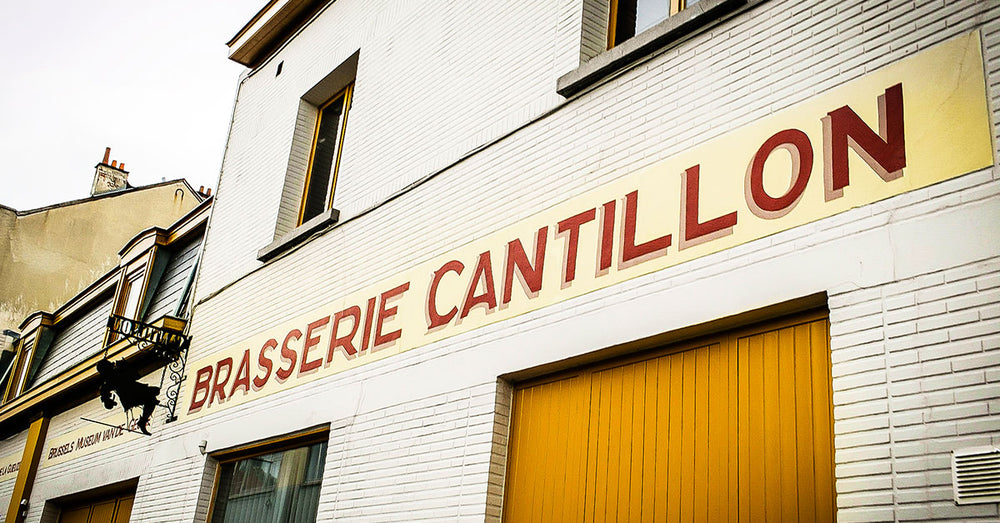Until the summer of 2012, I’d have told you I didn’t like beer. Didn’t buy it, didn’t drink it. And then I discovered the spontaneous, wild fermentation of the Belgian sour.
I was working on my PhD, researching a topic that had absolutely nothing to do with beer: I’d embarked on a Hannah Arendt-style journalistic trip to observe the trial of Ratko Mladić in The Hague. Mladić was being tried for genocide and crimes against. humanity for, among other acts, the massacre of thousands in Srebrenica in 1995, in the north of Bosnia. Mladić’s behaviour in the courtroom was as surprising as it was unsavoury. In the midst of graphic descriptions of mass violence (for which he’d later be convicted), the Serb military leader would interrupt, indignantly, requesting something to drink. It was a performance that was nearly unbearable to observe.
I was a first-timer in Benelux, and the weekends offered a reprieve from the odious oral records emerging in that courtroom in English, French, and Bosnian/Croatian/Serbian. Quick and regular trains run between The Hague and cities across Belgium; that’s commonplace for most Europeans, I’m sure, but wondrous for an American like me. Looking for an opportunity to think and write — by hand in a notebook, as I’ve always done and still do now — in interesting culinary spaces with a good drink, I struck out across the small region. It turned out this wouldn’t solely be a summer marked by the malignity of Mladić’s unthinkable crimes, but one that also left a very different kind of sour taste in my mouth.
I stopped first in Brussels and discovered there were no wines on the menus, just beers and spirits. I do love whiskeys and gins, but it felt a little foolish not to try the local fare. At La Porte Noire, a gorgeous and cave-like bar with a history dating back to the 16th century, I decided to give a bottled Gueuze (“GOOZ”) a try. I’m not ashamed to tell you I often choose my bottled drinks based on their graphic design, and the Cantillon label caught my eye. The colours, typeface, and line-drawn image of a playful imbiber struck me as a fin-de-siecle homage of sorts, so I placed an order. I took a sip and realised…
Oh my god. I do love beer.
Gueuze is a particular kind of lambic beer, and lambics, I learned, are fermented out in the open with wild yeasts. Gueuze is a mix of young and old lambics, aged for different periods of time and bottled for a second fermentation. The result is designed to be something especially unbridled and is often depicted with related olfactory descriptors: bales of hay, barnyards, horse stables. Take the images now blooming in your head and set them against a landscape at once pastoral and sublime: tungsten-coloured grasses holding their own against desperate winds. Add in the (wo)man-made aromas of leather saddles and freshly chopped oak, and the sounds of hoofbeats. That’s the tableau where my heart resides, so this beer seemed, quite naturally, made for me. It’s decidedly earthy, usually a rich golden colour, and wonderfully tart. Its hue mirrors the warm shade produced as the sun sets on dying foliage in autumn, the time of day long favoured by filmmaker Terrence Malick.
Belgian sours begin their lives like other beers, but particular bacteria turn them sour. I’m no biologist or brewmaster, so I can’t explain in detail, but those bacteria include lactobacillus, pediococcus, and Brettanomyces. So why aim to sour a globally popular drink with a centuries-long history?
The adjective “sour” is typically a pejorative one, referring to something that tastes unpleasant, wretchedly bitter to the tongue. We describe fruits as having “gone sour,” meaning they’re rancid and must be discarded. And of course, we talk about how forms of knowledge — like the painstakingly detailed crimes of a war criminal — metaphorically leave a sour taste in one’s mouth. The Belgian sour thus becomes much more than just a drink; it remakes the English language for those of us who covet it.
When it comes to lambics more broadly, you’ve got a lot of options. Some are mixed with fruit to balance out the tartness, often with cherry or apricot, sometimes strawberry. In these blends, the colour of the drink becomes imbued with the hue of the fruit. One of the great things about lambics, whether fruit-infused or not, is that they’ve got a relatively low ABV, especially if you’re usually a wine drinker. So, if you’re writing while drinking, you’re not limited to just one or two lambics. In July 2012, I continued my writing work at another spot in Brussels, Poechenellekelder (“puppet theatre”), a tavern adorned with vintage handmade performers and a great cheese selection. (You probably don’t need me to tell you lambics and cheese are a fab pair.) But even greater than the beer and cheese combination is one of the all-time great epicurean duos: moules frites and a Belgian sour. At Brussels restaurants like le Chou de Bruxelles, I discovered the great joy of eating mussels steamed in gueuze with a gueuze for drinking on the side.
That sour summer propelled my intellectual thinking into the dark depths of international jurisprudence, but it also invigorated me gastronomically: I was buoyed by trips to Antwerp, Ghent, and Bruges, where I learned about Flemish red ales. If you ask anyone in the know about the criterion by which Flemish sours are judged, they’ll probably point you to the Rodenbach Grand Cru. This was the first Flemish sour I tasted, and I was in love. It’s so sour that I don’t believe there’s a word in the English language to properly describe it — the beer’s flavour profile is itself an oxymoron. Acerbic pleasure. Astringent lushness. Something tells me there must be a German word for this, a lengthy combination of opposites that also includes a description of the beer’s unique shade. That colour itself is like an anthropomorphic character when I recall it; it’s a burnt crimson, a blend of carmine and vermillion that must have idled away its hours in the dark after long ago being set alight. Drinking a Flemish sour on the Bruges Markt — just outside the Basilica of the Holy Blood where there’s a cloth on display that’s said to hold the blood of Jesus — is a different kind of communion.
Flemish sours, I’ve been told, begin as malty ales before going into foeders, which are wooden barrels where yeasts and bacteria native to Flanders can ferment the brew. For the rest of my time in the region, I sought out Flemish red ales to soothe the bitter acerbity of the historic trial I was witnessing. Over the years, that doctoral research (and my academic work that emerged from it) soured me on the promise and possibilities of scholarly publishing. It was that bitter taste that led me to turn toward public writing, reframing my focus on culture, gender, music, and storytelling. Along with more fruitful modes of writing, my love of Belgian sours flourished, and I still seek them out everywhere.
Lambics can be difficult to find in the United States, but Flemish red ales — true Flemish sours — are especially difficult to come by. Craft breweries across the country offering “sour” ales clearly haven’t, in my mind, conjured the spirit of a real Belgian sour. I’ll try a sample and instantly know it’s not what I’m looking for. Their can, bottle, and on- tap offerings don’t come close to those sours indigenous to Benelux, the ones that opened my tastebuds to beer. I’m undoubtedly a Cerevisaphile, but only of the truly sour variety.
What is now more than a decade-long love of Belgian sours has led to glorious bar experiences for me in a range of places, and shrieks of excitement when I find a new Gueuze or Flemish red ale at a specialty beer shop. But my newfound love of beer has also shone a light on the gender norms that rule the beer industry, and what might have led me to presume I wasn’t a beer drinker originally.
For instance, one of my favourite places to order a Belgian sour with moules frites in the US is Granville Moore’s in Washington, D.C. Anytime I’m in the capitol, I make sure to put in a reservation. It’s one of the lone places in America where they really know what they’re doing when it comes to Belgian sours and steamed mussels, but it’s also a place where my knowledge of beer has been misogynistically tested. I’ll order a Rodenbach or a Duchesse de Bourgogne, and the server will inevitably begin explaining the beer to me. “That beer is really sour. Do you want to try something else instead, maybe one of the ciders?” I know it’s sour. “But it’s really sour. You might not like it.” Ugh, yes, yes, I know it’s sour, please just put in my order. Of course, it’s difficult to know definitively whether this explanatory framework is grounded in gender-based assumptions, but I do know when I’ve been at Granville Moore’s with men and they’re the first to order a Flemish red ale, they’ve not been subject to the same mansplaining.
As I’ve contemplated my relative distaste for lagers and the qualifying language I’ve been subjected to at stateside bars far beyond Granville Moore’s, I’ve also thought about all the sociocultural stuff that goes into making a beer aficionado — a more traditional Cerevisaphile. I think about how cans of Iron City and Labatt Blue were often the drink of choice for my grandfather and uncles, and later my own brothers, at holiday celebrations in my working-class family. Beer was and remains a language for them — of kinship, of love. Despite my grandfather’s vast intellectual curiosity and pride in my accomplishments, he never offered me a can of beer in his lifetime. I can’t say for certain whether or how these experiences shaped my early understanding of myself as a beer drinker (or not, as the case had long been). But it has shaped the way I think of myself as a Belgian sour lover now.
As a lambic and Flemish red ale die-hard, I get to change the gender-based assumptions around beer culture, open minds to the sublimity of Cantillon and Rodenbach bottles, and drink some truly delicious sours while writing — a cultural communion all of my own.
Audrey Golden is a writer based in New York with a focus on music, culture, cinema and politics. She has been a regular contributor to Louder Than War since 2019 and manages Louder Than War Radio where she is a weekly presenter.
Her book “I Thought I Heard You Speak: Women at Factory Records” is available from White Rabbit Books now.

